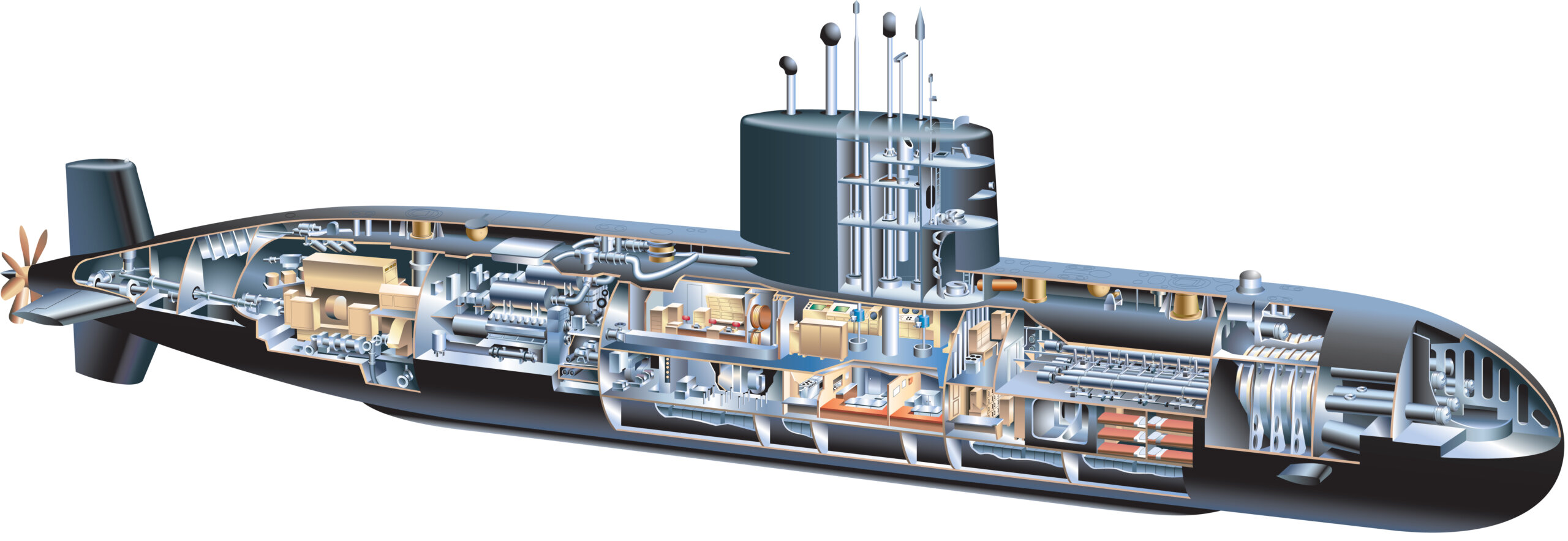
HMCS Windsor leaves Faslane, Scotland, for Halifax in 2003. The boat is the only one in Canada’s four-member submarine fleet to log sea days since 2021. [Alan Rowlands/Canadian Forces Maritime Command]
While talk of nuclear replacements has been just that—talk—only one of the country’s four Victoria-class subs, HMCS Windsor, has hit the water operationally since 2021, logging 43 days in 2022 and 14 in 2023.
The navy has acknowledged it’s short of sailors. It says it takes 503 submariners to run the fleet. It acquired 140 between 2019 and 2022 and only half had completed basic qualifications by October 2023.
But other problems have beset the 1980s-era diesel-electric submarines. In fact, they have given the navy fits since it began acquiring the vessels formerly known as Upholder-class boats from the Royal Navy in 2000—most recently in September, when a seawater storage tank aboard Windsor sprung a leak while it was on a crew training exercise off Nova Scotia, forcing the boat back to its home port of Halifax.
Three sailors were reported to have suffered minor injuries. The boat was struck by similar misfortune during its 2001 Canadian sea trials, when minor flooding forced it into an early refit.
Purchased at the bargain-basement price of $750 million, the Victoria-class vessels encountered serious electrical problems and mechanical issues from the start that limited their active service and the scope of their deployments.
In October 2004, a crewman aboard Chicoutimi died after a big wave hit while a lower hatch was open, thrusting 2,300 litres of water into the boat and causing electrical explosions that led to a series of major fires. Nine sailors were injured.

HMCS Windsor is the only one of Canada’s four Victoria-class submarines that has been to sea since 2021, logging 43 days in 2022 and 14 in 2023.
[DND]
Purchased at the bargain-basement price of $750 million, the Victoria-class vessels encountered serious electrical problems and mechanical issues from the start.
The Liberal government’s defence policy paper “Strong, Secure, Engaged,” issued months after it was first elected in 2016, said the operational life of each Victoria-class vessel would be extended by an additional life cycle, or about eight years.
The related upgrades are already underway and will ensure the boats’ “survivability against future threats” into the 2030s, notes a Defence Department summary.
Janes, the world authority on all things ship-related, reported in August that requests for proposals to conduct a Phase 2 modernization of the current fleet, including new sonar and periscopes, were expected by year’s end. The subs’ galleys are also to be upgraded. In total, there are 17 projects in various stages of development or consideration under the modernization program.
All four vessels were in a series of “deep-maintenance cycles,” which would present opportunities to install new equipment under the long-term modernization, reported the publication.
“The [modernization] work packages are being introduced in two phases,” it said. “The first phase will remove obsolescent equipment and address maintenance issues, while the second phase will see improvements to situational awareness and habitability.”

Originally operating as British-built Royal Navy Upholder-class boats, Canada’s 1980s-era Victoria-class submarines have provided more than their share of headaches since they were purchased at a bargain-basement price in the early-2000s. [DND]
The government is running out of time if it wants new submarines ready before the current ones are retired.
Meanwhile, the navy is pitching the purchase of up to 12 new submarines at a cost of $60 billion. The defence chief, General Wayne Eyre, told a defence conference in March 2023 that he was advocating submarines to be included in the government’s next defence policy update, which is expected soon.
The navy has been calling for replacements since July 2021. It will take at least 15 years to design and build new vessels.
Retired navy officer Adam MacDonald, now an adviser with Global Affairs Canada, said in March that the government is running out of time if it wants new submarines ready before the current ones are retired.
“Most people who really study this are basically saying there has to be a determination if you want to have a continuous submarine capability,” MacDonald said. “So, you basically need a decision now or within the next year or so.”
The typically mired Canadian effort comes as the United States, Britain and Australia put submarines at the heart of the new defence pact AUKUS.
The Ottawa Citizen reported in April that the navy had created the Canadian Patrol Submarine Project, or CPSP.
“The CPSP is examining all conventional options available, gathering information, and conducting an analysis of potential submarines capable of meeting the Royal Canadian Navy’s requirements,” National Defence spokesman Dan Le Bouthillier told the newspaper.
“The CPSP does not commit the government to any specific course of action, but is intended to facilitate an informed decision when required.”
The typically mired Canadian effort comes as the United States, Britain and Australia put submarines at the heart of the new defence pact, AUKUS, which aims to deter Chinese ambitions in the Indo-Pacific.
Australia plans to buy three to five Virginia-class nuclear-powered attack submarines with help from the U.S. and Britain. The Australian government projects the program will cost between $268 billion and $368 billion over 30 years.
Advertisement





















